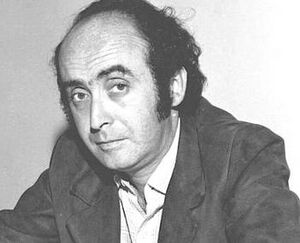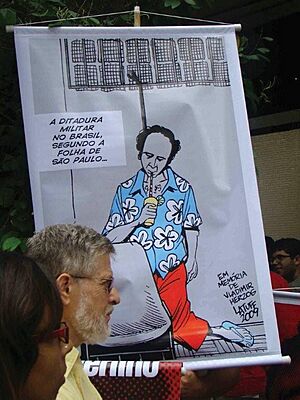Vladimir Herzog facts for kids
Quick facts for kids
Vladimir Herzog
|
|
|---|---|
 |
|
| Born |
Vladimir Herzog
27 June 1937 |
| Died | 25 October 1975 (aged 38) |
| Education | Bachelor's degree, University of São Paulo |
| Occupation | Journalist Professor Playwright |
| Spouse(s) | Clarice Herzog |
| Children | Ivo & Andre Herzog |
Vladimir Herzog (born June 27, 1937 – died October 25, 1975) was a famous Brazilian journalist. His friends and family called him Vlado. He was also a university professor and a writer of plays.
Vladimir Herzog was born in what is now Croatia. His family was Croatian-Jewish. He also loved photography and used it in his film projects.
Contents
Life Story of Vladimir Herzog
Early Years and Family Background
Vladimir Herzog was born in Osijek, Kingdom of Yugoslavia on June 27, 1937. His parents were Zigmund and Zora Herzog. They were a Jewish family from Croatia.
In the early 1940s, his family moved to Brazil. They left their home to escape danger from the Nazis and a group called the Ustashe.
Education and Journalism Career
In 1959, Herzog earned a degree in Philosophy from the University of São Paulo. He became a Brazilian citizen in 1961. After finishing his studies, he started working as a journalist.
He wrote for big newspapers in Brazil, like O Estado de S. Paulo. He decided to use "Vladimir" as his first name. He felt his real name, "Vlado," sounded too unusual in Brazil.
After a political change in 1965, Herzog and his wife, Clarice, moved to Britain. He worked for the BBC in London for three years. They came back to Brazil in late 1968.
In the 1970s, Herzog became the main editor of TV Cultura. This was a public TV station run by the government of São Paulo State. He also taught journalism at the University of São Paulo.
He also became a playwright, writing plays for the theater. Herzog joined a group working against the military dictatorship in Brazil. He was part of the Brazilian Communist Party.
As a news director, Herzog believed journalists should be responsible to society. He reported on the first ten years of the military rule in Brazil. Spies working for the government at the TV station saw him as a problem.
Arrest and Tragic Death
On October 24, 1975, Vladimir Herzog was the editor-in-chief of TV Cultura. Agents from the Brazilian Army asked him to come in for questioning. They wanted to know about his connections to the PCB Party, which was not allowed at the time.
The next day, Herzog went to the DOI-CODI, a government building. This meeting was a trick to question him. He was arrested along with two other journalists.
On October 25, Herzog's body was found in his prison cell. Many religious and human rights groups asked for an investigation. The Inter-American Commission on Human Rights looked into his death. They found that the Brazilian government arrested and caused Herzog's death because of his work as a journalist.
Aftermath of His Death
Herzog was married to Clarice Herzog, and they had two young children. Three years later, Clarice was able to legally say the government was responsible for her husband's death. A court agreed and gave money to Herzog's family.
Vladimir Herzog's death made many people angry. It led to big protests from news groups around the world. It also started a movement to protect human rights in Latin America.
Many people believe Herzog's death marked the beginning of the end for the military dictatorship in Brazil. He is now a symbol of the fight for democracy in Brazil. A street in São Paulo where TV Cultura is located is named after him. There is also a special award for journalism about human rights named after him, called the Prêmio de Jornalismo Vladimir Herzog.
Herzog's Lasting Legacy
In 2009, more than 30 years after Herzog's death, the Vladimir Herzog Institute was created. This institute collects information about Herzog. It also encourages discussions about the role of journalists and new media.
The institute gives out the Vladimir Herzog Prize. This award honors journalists and human rights activists.
See also
 In Spanish: Vladimir Herzog para niños
In Spanish: Vladimir Herzog para niños


